All is Right in the World
Posted: April 22, 2024 Filed under: Gardening | Tags: Amaryllis, Automatic Gardening, Caterpillar, Gulf Coast gardening, Hummingbird, Southern Gardening, Subtropical Gardening 18 Comments
At last, the garden beds are full and bursting with color.
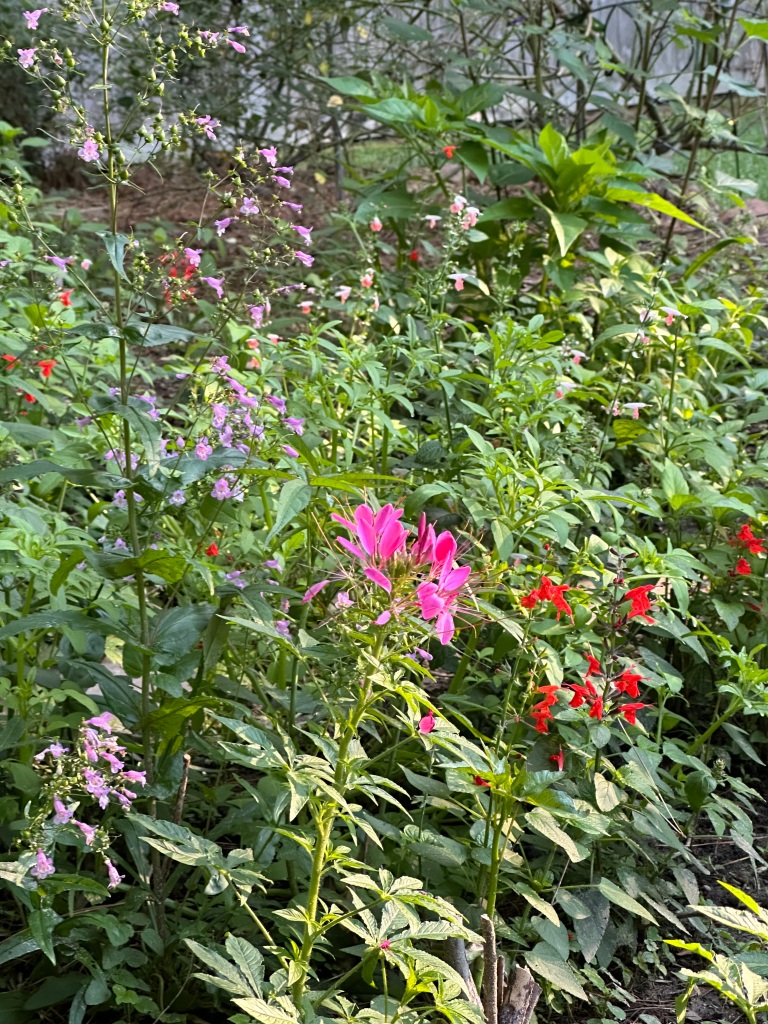
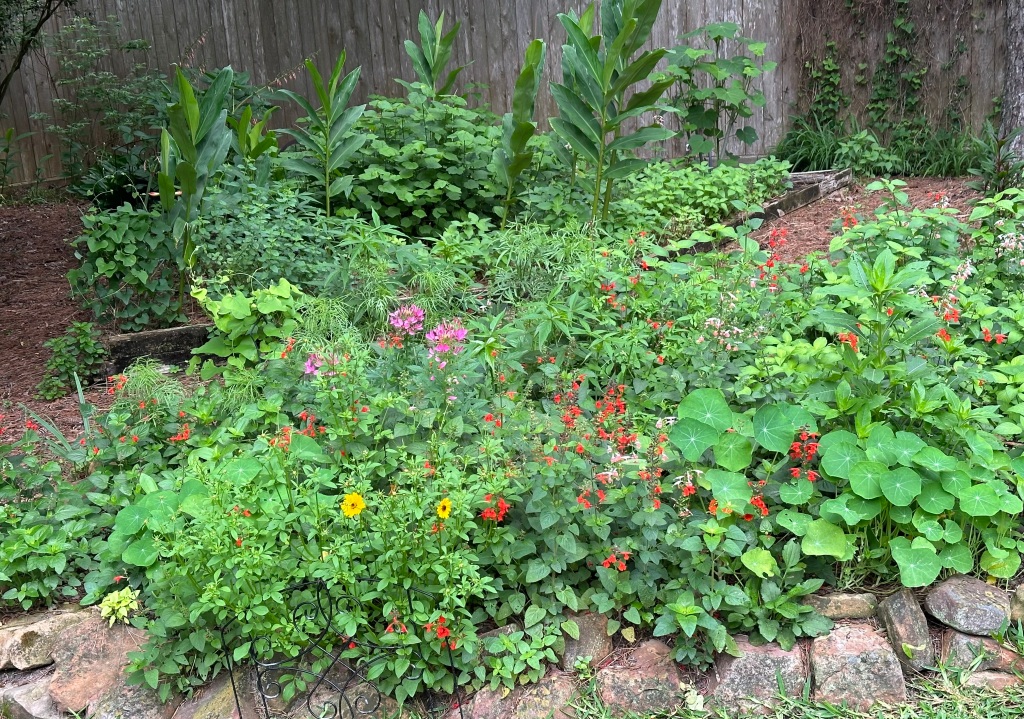
Many of these flowers would have been blooming earlier but were knocked back by freezing weather.
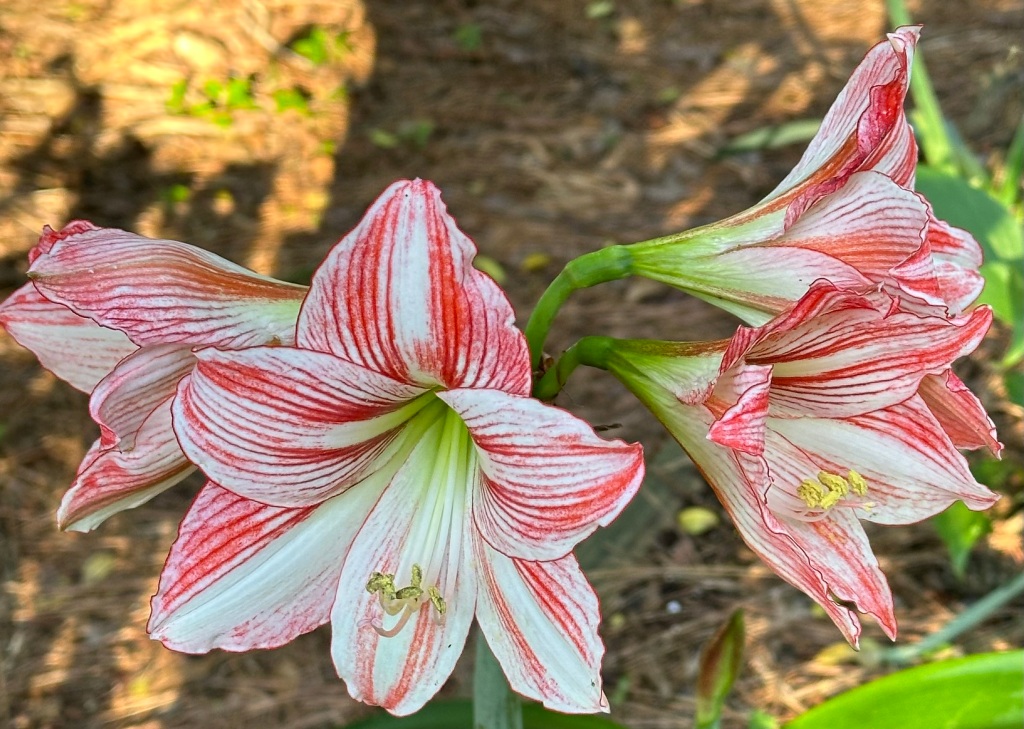
Thankfully, the Amaryrillias bulb did not turn to mush and it put on a beautiful display. A second stem with buds is coming up.
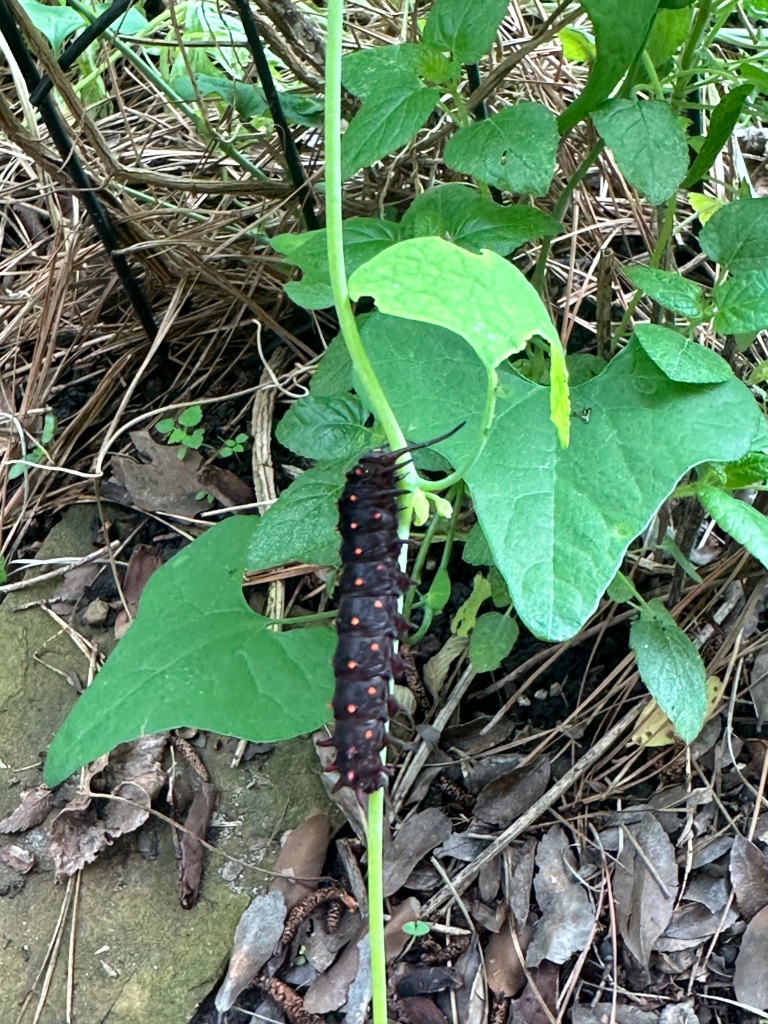

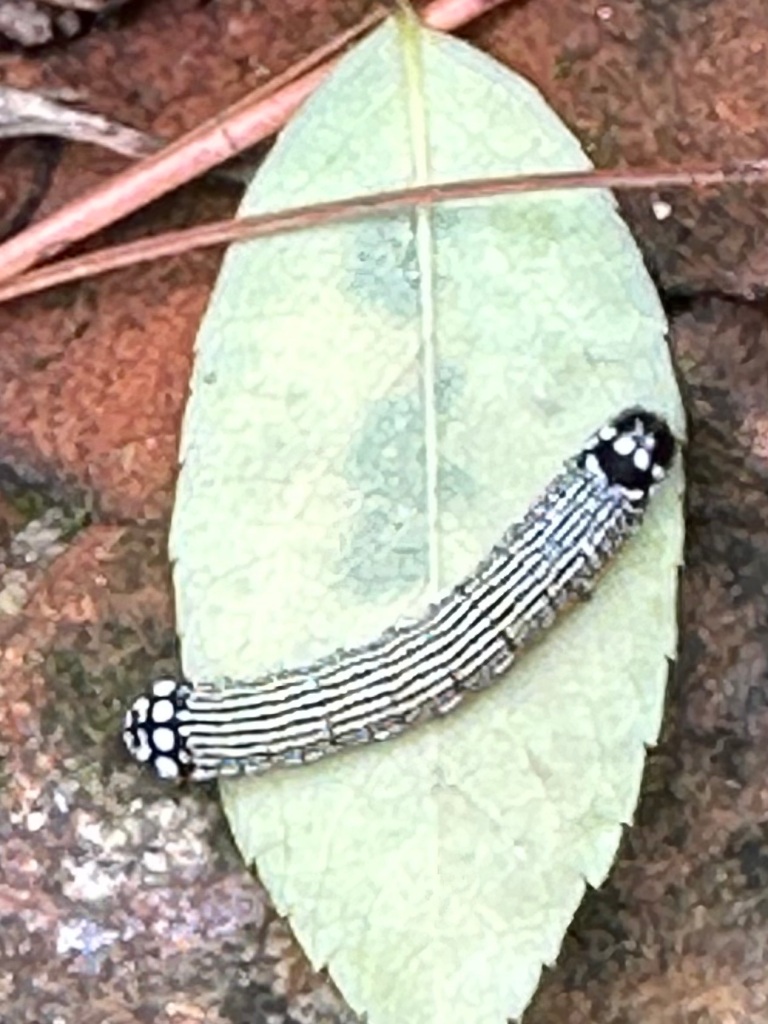
A variety of caterpillars have hatched.
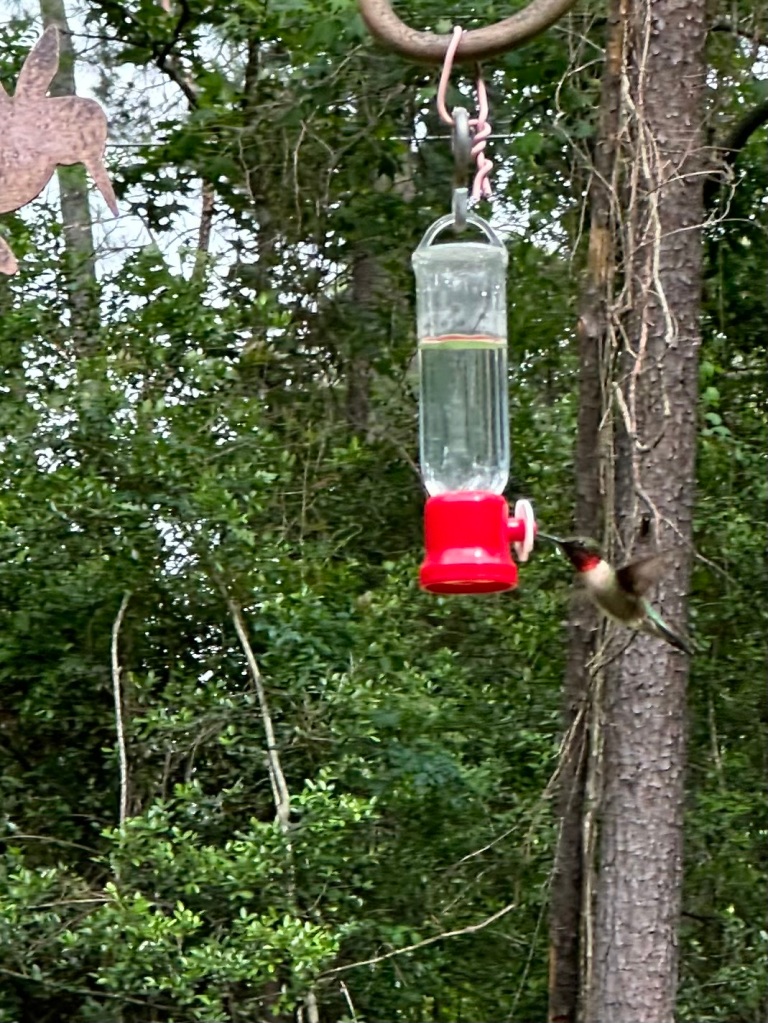
And the hummingbirds have come back. All is right in my backyard world.
Green on Green
Posted: August 29, 2023 Filed under: Gardening | Tags: Backyard Critters, Green Anole, nature photography, Southern Gardening, Subtropical Gardening 14 Comments
Green on green with my favorite lizard. A green anole is hanging out on a big leaf. The blue around its eye really pops. Click to enlarge.

I found this green anole licking up dewdrops.

When it was finished drinking, the lizard posed for its close-up.
Palmettos
Posted: August 14, 2023 Filed under: Gardening | Tags: Gulf Coast gardening, My Kitchen Window, Palmettos, Sabal minor, Subtropical Gardening 24 Comments
Sabal minor Palmettos grow wild in my area. This one has been at the edge of my little woods since we built our house.

I put a watering can near some frons I cut off to give an idea of their size. Native people used them thatch their roofs.

For years I only had one and now others are coming up in my big wooded area. Gardeners are told to never plant Palmettos, as they can not be killed.

Across the street where the land is lower and wetter, the Palmettos line the greenbelt.

It is said that places, where the Palmettos grow, are prone to flooding. That has been true for the low area on the other side of the street.
The Fertilizer Wagon
Posted: May 3, 2023 Filed under: Gardening | Tags: Gulf Coast gardening, nature photography, Southern Gardening, Subtropical Gardening 10 Comments
It was time to pull out the fertilizer wagon once again. Our azaleas and camellias require three rounds of fertilizer in the spring. I use general azalea fertilizer and one that is systemic to protect against insects for the ailing azaleas and camellias. While I was at it, I hit the other shrubs. The wagon was bought for the kids years ago and I think I have gotten the most use out of it and utilize it for anything I have to haul around the yard.
Gardening Woes
Posted: March 27, 2023 Filed under: Gardening | Tags: Green China Rose, Gulf Coast gardening, lettuce, Nasturtium, seasonal allergies, Subtropical Gardening 28 Comments
There are times when things don’t always go as planned in the garden. I am blaming my mistakes on allergy head, as this year my seasonal allergies are worst than ever.
I noticed some plants coming up where something else had been planted. I couldn’t recognize them by their first leaves but didn’t think they were a weed. The plants finally revealed themselves as a nasturtium. I wondered how did they get there so far from where I usually plant them? Finally, I remembered that when I was organizing my seeds, I found what I thought were Dancing Ladies seeds and planted them in that very spot. Mystery solved.

Next, blaming my slow-acting allergy brain and ducking under bushes to weed, I spotted these unusual red plants. When I stood up and oriented my view I saw the red plants were actually new canes coming up from the Green China Rose.

Because of my lack of motivation, again I blame it on my allergy head, I never planted my early spring lettuce. A big mistake, as a leftover seed germinated and grew into a big healthy plant without any care.
I would love to hear if anyone else is experiencing worse than usual seasonal allergies or your garden faux pas…just to make me feel better.
The Best Part of Winter
Posted: January 2, 2023 Filed under: Gardening | Tags: Blue Norther, Camellia sasanquas, Gulf Coast gardening, Subtropical Gardening, Year-round gardening 12 Comments
Camellias are the highlight of winter here and start blooming at the end of October. These beautiful shrubs bloom when the temperatures cool, filling in for all the summer flowers that have finished their blooming time.

The Camellia sasanqua bloom first. They resemble a rosebud when opening.

This year the Camellias were very prolific and every shrub was full of buds.


I could not stop taking photos and it was hard to choose which ones to post.

Even the Camellia sasanqua that was grafted with two different colors simultaneously bloomed for the first time. Usually, the white blooms first.




I hope you enjoyed my winter flowers, Unfortunately, all the flowers froze from the Blue Norther that hit before Christmas. The Japonica camellias have not bloomed yet and hopefully, the tight buds made it through the freeze.
https://www.texasmonthly.com/being-texan/texas-primer-the-blue-norther/
And the Winner Is…
Posted: December 30, 2022 Filed under: Gardening | Tags: Arctic Blast, Subtropical Gardening, viola, Year-round gardening 11 Comments
Violas! These sweet little plants survived the Arctic cold. I bought a few to fill in a bed and I will definitely keep them in mind for next winter.
A New Year and New Beginnings
Posted: December 29, 2022 Filed under: Gardening | Tags: Arctic Blast, Blue Norther, Gulf Coast gardening, Subtropical Gardening 16 Comments
Well, new beginnings for all my garden plants. The Arctic freeze that roared down from the top of the world sent our normally semitropical temperature down to 13 degrees. Here in Texas, we call that kind of front a Blue Norther. There is nothing but flat plains between us and the Arctic. Texas Monthly has a great article on the subject.
https://www.texasmonthly.com/being-texan/texas-primer-the-blue-norther/

This is the third year in a row that a hard freeze, which is three hours or more below 28 degrees, has hit our area and it lasted about four days this time. Every plant left outside has frozen. I haven’t peeked under the frost cloth that I put over a few plants. I’m sure it won’t be good.
Living along the Gulf Coast in a semitropical climate we are able to grow plants that are used to warm weather all year. I have learned to keep my special tropical plants in pots that can be moved inside for cold snaps. The rest of my garden plants are usually root hardy enough to come back, such as the begonias in my last post.

There is no need to make New Year’s resolutions, as Mother Nature has provided them for me. I have hours of exercise ahead as I clean out my 12-plus beds of plants. Mother Nature will be helping out with that task, as the temperature will be heading back up to the 70s.
Ruby Supreme Guava
Posted: October 22, 2022 Filed under: Gardening | Tags: Gulf Coast gardening, Psidium guajava, Ruby Supreme Guava, Subtropical Gardening 22 Comments
I was given the gift of a Ruby Supreme Guava. It has made flowers but never fruit. Right before I left for an extended vacation, I snapped a quick, but an out-of-focus photo of the fruit not expecting it to amount to anything.

What a surprise awaited me when I came home. The tiny fruit grew to full size and was not eaten by the wild animals that inhabit my yard. I guess they considered it foreign food.

The guava’s botanical name is Psidium guajava and the inside is a beautiful dark pink color.








